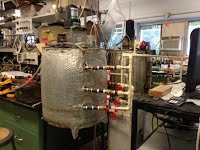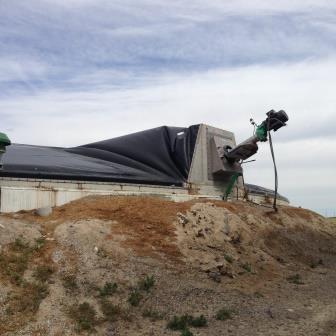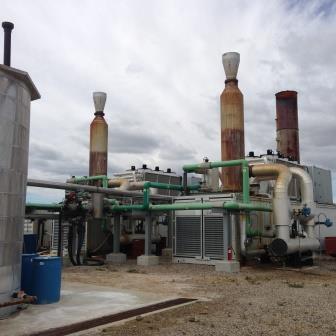Anaerobic Digester
The anaerobic digester (AD) takes in the residual, pre-fermented manure from the fermenter. The primary purpose is to produce biogas, which is a combination of methane and carbon dioxide. In order for gas to be produced, the reactions must occur in oxygen-free (anaerobic) conditions. When integrated into a two-stage AD, this is the second stage, known as the gas phase. However, for the purposes of the integrated dairy manure processing, these two steps must be separated to enable the volatile fatty acid (VFA)-rich liquid stream to be fed into the PHA reactor.

The reactions that take place are driven by a class of bacteria called methanogens that create the methane and carbon dioxide. The two most important operating variables are temperature and solids residence time (SRT). The high temperature generally causes reactions to occur faster, although excess temperature can inhibit or kill bacteria. SRT is the amount of the time material stays in the reactor. This is related to the amount of new “food” the bacteria receive and the amount of product (in this case, methane) that can be produced in a given amount of time. Each reactor has an ideal operating temperature and SRT to obtain the highest yields, but the ideal values usually vary between reactors. Another parameter that is important for figuring out how well the AD processes the added carbon-containing compounds is the organic loading rate (OLR). This quantity tells how much organic matter the reactor is processing, which is not the same as the volume or amount of material. The biogas product mentioned above is composed of approximately 60% methane and 40% carbon dioxide. There are several ways this gas can be used. The gas may be used to produce electricity that can be sold to the power grid. Biogas produced by the methods outlined here may be more consistent in composition than biogas produced conventional ADs; since power companies often require relatively consistent rates of supply, this may be more possible with this system of AD.1 If the gas cannot be sold back to the power grid, some of it can still be burned at the dairy in order to generate electricity and reduce the electricity consumption of the farm. A portion of the carbon dioxide may be diverted to serve as the carbon source for the algae raceways.
The byproducts of this process are liquids and digested solids. These will be separated and can be sold. The liquids can be sold as a soil amendment fertilizer, and the solids can be sold for animal bedding. Though these are not very high-value products, they do contribute overall to the economic viability of the system.
 |  |
| Mixer installed in partially underground AD | Electricity generating equipment |
1 Coats E.R., Ibrahim I., Briones A. and Brinkman C.K. (2012). Methane Production on thickened, pre-fermented manure, Bioresource Technology 107, 205-212.

